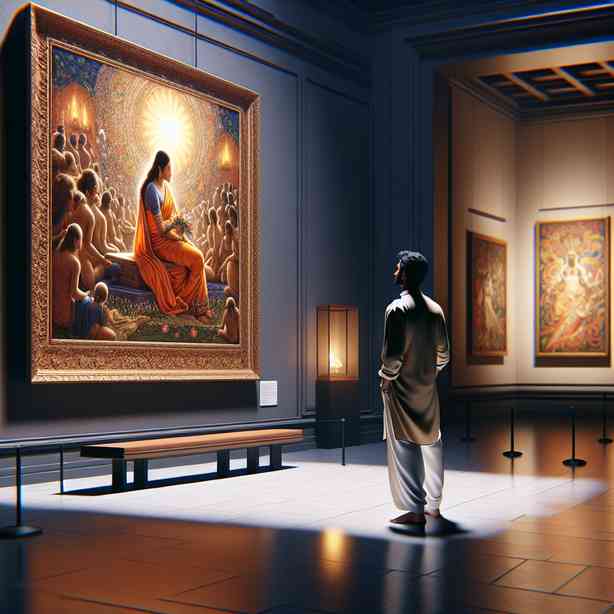
In the realm of art, paintings serve as a bridge connecting our inner emotions with the outer world. They evoke feelings, stir memories, and sometimes, quite unexpectedly, bring tears to our eyes. When you cried in front of a painting, it wasn’t merely an instance of sadness or overwhelming emotion; it was a profound experience that resonates with the depths of human existence.
Art, in its various forms, invites us to confront and explore emotions that might lie dormant within us. When we stand in front of a painting, we are not just observing colors, shapes, and lines; we are engaging in a silent dialogue with the artist and, by extension, with ourselves. Every brushstroke carries the intensity of the artist’s thoughts, struggles, and aspirations. This connection can elicit strong responses, sometimes making tears flow as we resonate with the depicted scenes or the emotions they evoke.
Consider the imagery within a painting. A landscape can remind us of a beloved place, prompting nostalgia and longing. A portrait may capture the essence of a person who resembles a cherished memory or evokes memories of lost loved ones. In these moments, crying becomes a cathartic release, a way to express feelings that words often fail to convey. In front of that painting, we allow ourselves to feel, to remember, and to connect with the broader narrative of human experience.
The act of crying in front of art can also be a moment of reflection on our struggles and triumphs. The stories portrayed in visual art can mirror our own journeys, making us confront aspects of our lives we may often overlook. For instance, a painting depicting suffering, despite its despair, can spark a realization of our resilience and strength. Art often compels us to face the uncomfortable truths of our existence, and in doing so, we may find solace through tears.
Crying in front of a painting is sometimes misunderstood as a manifestation of weakness. However, it is, instead, the recognition of our shared vulnerability as human beings. Artists pour their souls into their work, and when we cry, we acknowledge the depths of their feelings. In appreciating art, we find validation for our own emotions, understanding that it is perfectly okay to be moved to tears by something exterior to ourselves. This shared emotional space encourages us to reflect on not just the artwork but also the intricacies of life that it represents.
Moreover, art’s ability to evoke tears can also be attributed to its timeless quality. A painting may encapsulate a moment in history, a cultural significance, or a universal theme that transcends time. For example, witnessing a portrayal of war, love, loss, or joy can remind us of societal challenges and human relationships that continue to persevere even today. Thus, when we cry in front of a painting, it is often a response not solely to the artwork itself but to the collective human condition encapsulated within it.
The emotional journey elicited by a painting can differ widely among viewers, highlighting the subjective experience of art appreciation. Each person brings their history and emotional baggage, facilitating a unique interaction with the artwork. As one might cry at the sight of a masterpiece depicting heartbreak, another may find solace in a painting that inspires hope. This diversity of emotional reaction underscores the power of art as a medium for personal and communal expression.
Additionally, being vulnerable in front of a painting opens us to personal growth. It invites us to confront our emotions instead of shying away from them. By acknowledging and allowing ourselves to cry, we embark on a journey of self-discovery, identifying the experiences or truths that resonate deeply. This emotional acknowledgment can foster healing, making space for newfound awareness and understanding.
The experience of crying in front of a painting also serves as a reminder of the importance of art in our lives. It prompts us to seek out what moves us and encourages us to appreciate the beauty and complexity of the world around us. Engaging with art can cultivate a deeper awareness of not just our emotions but also those of others, fostering empathy and compassion in our interactions and relationships.
As we navigate our lives, the moments we spend in the presence of art can anchor us, offering respite and reflection. The next time you find yourself moved to tears in front of a painting, acknowledge that this is part of a larger dialogue about our humanity. This encounter can remind you that art is not just an aesthetic pursuit but a powerful medium through which we can communicate and process our experiences.
In conclusion, crying in front of a painting is an intricate and profound experience that encompasses a range of emotions and reflections. It symbolizes our ability to connect with art on a deeply human level, reminding us of the power of vulnerability and the universality of our emotional experiences. Ultimately, art invites us to open our hearts and minds to all facets of existence, illuminating the path towards understanding ourselves and each other more deeply. Embrace those moments of tears as they reflect your journey and the shared stories of humanity, and remember that art, in its many forms, continues to serve as a profound source of connection and healing in our lives.


